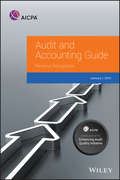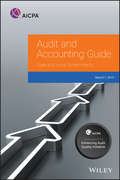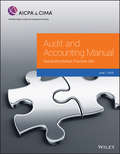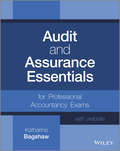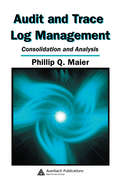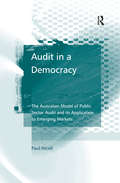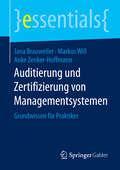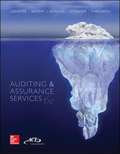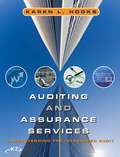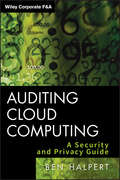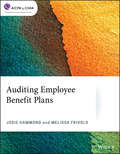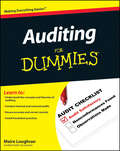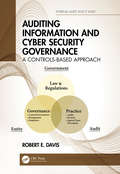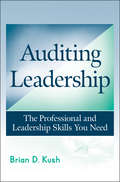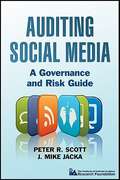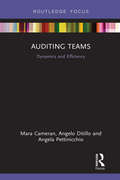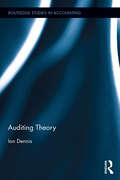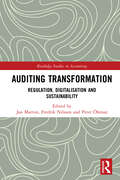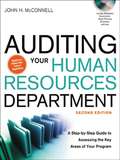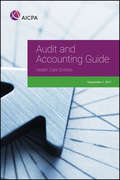- Table View
- List View
Audit and Accounting Guide: Revenue Recognition 2019 (AICPA Audit and Accounting Guide)
by AicpaASC 606, Revenue from Contracts with Customers, replaces almost all previously existing revenue recognition guidance, including industry-specific guidance. That means unprecedented changes, affecting virtually all industries and all size organizations. For preparers, this guide provides the comprehensive, reliable accounting implementation guidance you need to unravel the complexities of this new standard. For practitioners, it provides in-depth coverage of audit considerations, including controls, fraud, risk assessment, and planning and execution of the audit. Recent audit challenges are spotlighted to allow for planning in avoiding these new areas of concern. This guide includes 16 industry-specific chapters for the following industries: Aerospace and Defense, Airlines, Asset Management, Broker-Dealers, Construction Contractors, Depository Institutions, Gaming, Health Care, Hospitality, Insurance, Not-for-Profits, Oil and Gas, Power and Utility, Software, Telecommunications, and Timeshare.
Audit and Accounting Guide: State and Local Governments 2018 (AICPA Audit and Accounting Guide)
by AicpaWith all the recent changes in state and local government audit and accounting, including changes to some of the more complex areas such as pensions and post-employment benefits other than pensions (OPEB), accountants and financial managers can't afford to be without the most current guidance. This authoritative guide provides complete coverage of audit and accounting considerations critical for both preparers and auditors. This edition includes two new schedules: Governmental Employer Participation in Single-Employer Plans: Illustrative Schedule of Pension Amounts and Report; and, Illustrative Notes to Schedule of Employer Allocations and Schedule of Pension Amounts. It also provides insights, comparisons, and best practices for financial reporting and the financial reporting entity, revenue and expense recognition, capital asset accounting, the elements of net position, accounting for fair value, municipal securities offerings, tax abatements and much more.
Audit and Accounting Guide: State and Local Governments 2019 (AICPA Audit and Accounting Guide)
by AicpaState and local government audit and accounting is changing rapidly. This title features insights, comparisons, and best practices for some of the more complex areas such as pensions and post-employment benefits other than pensions (OPEB), this authoritative guide provides complete coverage of audit and accounting considerations critical for both preparers and auditors. This edition includes dual guidance for accountants and auditors early implementing GASB Statement No. 84, Fiduciary Activities. Topics covered also include: • Financial reporting and the financial reporting entity • Revenue and expense recognition • Capital asset accounting • The elements of net position • Accounting for fair value • Municipal securities offerings • Tax abatements
Audit and Accounting Manual: Nonauthoritative Practice Aid, 2019 (AICPA)
by AICPAThis comprehensive, step-by-step guide provides a plain-English approach to planning and performing audits. In this handy resource, accountants and auditors will find updates for the issuance of SAS No. 132, The Auditor's Consideration of an Entity's Ability to Continue as a Going Concern, with illustrative examples, sample forms and helpful techniques ideal for small- and medium-sized firms Key Features include: • Comprehensive and step-by-step guidance on the performance of an audit • Numerous alerts that address the current-year developments in a variety of areas • Illustrative examples and forms to facilitate hands-on performance of the audit
Audit and Assurance Essentials
by Katharine BagshawAn accessible beginner's guide to the fundamentals of audit and assurance Audit and assurance is a basic and vital aspect of the financial world and a key element of all professional accountancy programs. Whereas professional training on the topic frequently immerses students in too much detail while glossing the basics, this book begins with the fundamentals and expands to cover the details in a more measured way. With practical examples and end-of-chapter examples, External Audit and Assurance Essentials breaks down a difficult and challenging field of professional accounting.
Audit and Trace Log Management: Consolidation and Analysis
by Phillip Q. MaierAs regulation and legislation evolve, the critical need for cost-effective and efficient IT audit and monitoring solutions will continue to grow. Audit and Trace Log Management: Consolidation and Analysis offers a comprehensive introduction and explanation of requirements and problem definition, and also delivers a multidimensional solution
Audit in a Democracy: The Australian Model of Public Sector Audit and its Application to Emerging Markets
by Paul NicollExploring the role of public sector audit in emerging democracies and developing countries, this book provides an account of the relationship between the public sector auditor, the legislature and executive government. In particular, it introduces public sector audit's capacity to assess government agencies' compliance with the law and their management of taxpayer or internationally funded programs and services. The volume: ¢ Explores the Australian model of public sector audit. ¢ Provides a definition of a supreme Audit Institution (SAI) and the role and responsibilities of the public sector auditor. ¢ Examines the authority necessary for the SAI to function effectively. ¢ Discusses likely future reform of the SAI's legal framework. ¢ Illustrates how audit can be used to strengthen democratic institutions in emerging market economies. It will be of use to researchers, academics and students interested in the critical issues surrounding audit in general and public sector audit in particular. It will also be a valuable guide to practitioners in this area.
Auditierung und Zertifizierung von Managementsystemen: Grundwissen für Praktiker (essentials)
by Jana Brauweiler Markus Will Anke Zenker-HoffmannJana Brauweiler, Markus Will und Anke Zenker-Hoffman erläutern Arten und Einsatzbereiche von Audits sowie die Planung, Vorbereitung, Durchführung und Auswertung sowohl von internen als auch von Zertifizierungsaudits, beispielhaft dargestellt an UMS-Audits. Außerdem wird auf Qualifikationsanforderungen von Auditoren eingegangen. Die AutorInnen schließen mit methodischen Hinweisen zur Gewährleistung eines wertschätzenden Charakters von Audits, zu Fragearten und -techniken, zur Wahrnehmung von Informationen sowie zum Umgang mit Widerständen und Einwänden bei der Auditierung.
Auditing And Assurance Services
by Jerry R. Strawser Jay C. Thibodeau Allen D. Blay Penelope BagleyAs auditors, we are trained to investigate beyond appearances to determine the underlying facts―in other words, to look beneath the surface. From the Enron and WorldCom scandals of the early 2000s to the financial crisis of 2007–2008 to present-day issues and challenges related to significant estimation uncertainty, understanding the auditor’s responsibility related to fraud, maintaining a clear perspective, probing for details, and understanding the big picture are indispensable to effective auditing. With the availability of greater levels of qualitative and quantitative information (“big data”), the need for technical skills and challenges facing today’s auditor is greater than ever. The author team of Louwers, Blay, Sinason, Strawser, and Thibodeau has dedicated years of experience in the auditing field to this new edition of Auditing & Assurance Services, supplying the necessary investigative tools for future auditors.
Auditing And Assurance Services, 6th Edition
by Timothy J. Louwers Robert J. Ramsay David H. Sinason Jerry R. Strawser Jay C. ThibodeauAuditing And Assurance Services
Auditing And Assurance Services: Understanding The Integrated Audit
by Karen L. HooksPrinciples of Auditing presents auditing from the perspective of an integrated audit complying the Sarbanes Oxley Act (SOX), under the standards of the Public Companies Accounting Oversight Board. It is the first textbook completely authored after SOX, and consequently uses the integrated audit model throughout. In addition, this text also facilitates an understanding of audits of non-public companies. A primary focus is the need for auditors to understand their clients and their industries. Highlighted illustrative industries include: health care providers, retail enterprises, the automotive industry, and the land development and home building industry.
Auditing Cloud Computing
by Ben HalpertThe auditor's guide to ensuring correct security and privacy practices in a cloud computing environment Many organizations are reporting or projecting a significant cost savings through the use of cloud computing--utilizing shared computing resources to provide ubiquitous access for organizations and end users. Just as many organizations, however, are expressing concern with security and privacy issues for their organization's data in the "cloud. " Auditing Cloud Computing provides necessary guidance to build a proper audit to ensure operational integrity and customer data protection, among other aspects, are addressed for cloud based resources. Provides necessary guidance to ensure auditors address security and privacy aspects that through a proper audit can provide a specified level of assurance for an organization's resources Reveals effective methods for evaluating the security and privacy practices of cloud services A cloud computing reference for auditors and IT security professionals, as well as those preparing for certification credentials, such as Certified Information Systems Auditor (CISA) Timely and practical, Auditing Cloud Computing expertly provides information to assist in preparing for an audit addressing cloud computing security and privacy for both businesses and cloud based service providers.
Auditing Ecosystem and Strategic Accounting in the Digital Era: Global Approaches and New Opportunities (Contributions to Finance and Accounting)
by Umit Hacioglu Tamer AksoyThis book examines current topics and trends in strategic auditing, accounting and finance in digital transformation both from a theoretical and practical perspective. It covers areas such as internal control, corporate governance, enterprise risk management, sustainability and competition. The contributors of this volume emphasize how strategic approaches in this area help companies in achieving targets. The contributions illustrate how by providing good governance, reliable financial reporting, and accountability, businesses can win a competitive advantage. It further discusses how new technological developments like artificial intelligence (AI), cybersystems, network technologies, financial mobility and smart applications, will shape the future of accounting and auditing for firms.
Auditing Employee Benefit Plans (AICPA)
by Josie Hammond Melissa FrivoldMaster the fundamentals of auditing employee benefit plans in accordance with AICPA standards and ERISA rules and regulations. Written by a member on the expert panel for employee benefit plans, this book is designed to give an understanding of the requirements and audit procedures related to defined contribution, defined benefit, and health and welfare plans to help accountants more effectively plan and carry out their audit. Topics include: FASB ASU 2017-06, which significantly impacted master trust accounting, reporting and disclosures for employee benefit plans PCAOB adopted AS 3101 in 2017 which resulted in significant changes to the existing auditor's report. New insert for SAS No. 136, Forming an Opinion and Reporting on Financial Statements of Employee Benefit Plans Subject to ERISA
Auditing Essentials
by Frank GioveREA's Essentials provide quick and easy access to critical information in a variety of different fields, ranging from the most basic to the most advanced. As its name implies, these concise, comprehensive study guides summarize the essentials of the field covered. Essentials are helpful when preparing for exams, doing homework and will remain a lasting reference source for students, teachers, and professionals. Auditing includes audit functions, audit reports, professional ethics, legal liability, engagement planning, internal control structure in manually operated systems, internal control structure in EDP systems, evidence gathering, audit techniques, audit sampling, revenue and collection cycles, acquisition and payment cycles, payroll and inventory cycles, financing and repayment cycles, and other types of engagements.
Auditing For Dummies
by Maire LoughranThe easy way to master the art of auditingWant to be an auditor and need to hone your investigating skills? Look no further. This friendly guide gives you an easy-to-understand explanation of auditing -- from gathering financial statements and accounting information to analyzing a client's financial position. Packed with examples, it gives you everything you need to ace an auditing course and begin a career today.Auditing 101 -- get a crash course in the world of auditing and a description of the types of tasks you'll be expected to perform during a typical day on the jobIt's risky business -- find out about audit risk and arm yourself with the know-how to collect the right type of evidence to support your decisionsAuditing in the real world -- dig into tons of sample business records to perform your first auditFocus on finances -- learn how both ends of the financial equation -- balance sheet and income statement -- need to be presented on your client's financial statementsSeal the deal -- get the lowdown on how to wrap up your audit and write your opinionAfter the audit -- see the types of additional services that may be asked of you after you've issued your professional opinionOpen the book and find:A day in the life of an auditorWho gets audited and whyProfessional standards and ethicsHow to assess audit riskTips on collecting and documenting audit evidenceThe best way to get to know your clientAuditing practices for every business angle (revenue, purchases, personnel, and more)What you'll need to complete the auditLearn to:Understand the concepts and theories of auditingConduct internal and external auditsEnsure accurate and correct recordsAvoid fraudulent practices
Auditing Information and Cyber Security Governance: A Controls-Based Approach (Internal Audit and IT Audit)
by Robert E. Davis"A much-needed service for society today. I hope this book reaches information managers in the organization now vulnerable to hacks that are stealing corporate information and even holding it hostage for ransom." – Ronald W. Hull, author, poet, and former professor and university administrator A comprehensive entity security program deploys information asset protection through stratified technological and non-technological controls. Controls are necessary for counteracting threats, opportunities, and vulnerabilities risks in a manner that reduces potential adverse effects to defined, acceptable levels. This book presents a methodological approach in the context of normative decision theory constructs and concepts with appropriate reference to standards and the respective guidelines. Normative decision theory attempts to establish a rational framework for choosing between alternative courses of action when the outcomes resulting from the selection are uncertain. Through the methodological application, decision theory techniques can provide objectives determination, interaction assessments, performance estimates, and organizational analysis. A normative model prescribes what should exist according to an assumption or rule.
Auditing Leadership
by Brian D. KushHow can you start a culture of feedback that improves your organization?Turn to page 27.Want to know the most important word to an auditor?Turn to page 65.Do you train people to interrupt you? Want to stop?Turn to page 106.What is the single biggest opportunity to improve your audit?Turn to page 172.Want to hear about the funnier side of auditing?Turn to the "You Know You Are an Auditor When..." Appendix on page 227.Praise for Auditing Leadership: The Professional and Leadership Skills You Need"From networking to e-mail, from team-building to selling yourself, Brian shows how to create a well-organized and effective working life. Although aimed at auditors, the countless ideas put forth in this book can be used by individuals in every field to grow and become more successful in their chosen careers. In fact, one particular assertion summed up the entire thesis for me: 'success is a mind-set, not a finish line.' Kush offers a multitude of unique and creative suggestions for establishing that mind-set."--Joe Hoyle, Associate Professor of Accounting, University of Richmond, and cofounder, www.CPAreviewforFREE.com"Auditing Leadership is a must-read for new graduates and a solid resource for seasoned professionals. Brian Kush has taken a wide range of best practice advice and distilled it into a fantastic handbook for the auditing profession."--Andrew Prather, CPA, Shareholder, Clark Nuber PS"Brian's book takes you beyond the technical skills of auditing to help you become both a professional and a leader. The scope of topics covered is impressive, from e-mail communications to accountability to planning your future. The book includes sound, actionable advice that will benefit auditors at all stages of their careers, from staff to partner."--Louise M. Peabody, CPA, Member, Watkins Meegan, LLC
Auditing Ownership: Measuring Your Organization's Employee and Customer Ownership Capabilities
by James L. Heskett Joe Wheeler W. Earl Sasser Jr.Is your organization capable of making the transition to an ownership state of mind, focusing on the kinds of practices and processes that foster and sustain employee and customer owners? This chapter provides a tool for assessing your ownership capabilities. The ownership audit is intended as more than just a checklist of "must do's" to achieve a higher level of employee and customer ownership in your organization. It is designed to be used periodically to track progress in the various inputs that lead to the results reflected in the ownership quotient itself.
Auditing Social Media: A Governance and Risk Guide
by J. Mike Jacka Peter R. ScottPractical, big-picture guidance toward a mastery of social media benefits and the risks to avoidPacked with useful web links, popular social media tools, platforms, and monitoring tools, Auditing Social Media shows you how to leverage the power of social media for instant business benefits while assessing the risks involved. Your organization sees the value in social media and wants to reach new markets, yet there are risks and compliance issues that must be considered. Auditing Social Media equips you to successfully partner with your business in achieving its social media goals and track it through strong metrics.Shows how to ensure your business has adequate metrics in place to capitalize on social media while protecting itself from excessive riskReveals how to ensure your social media strategy is aligned with your business's goalsExplores the risk and compliance issues every business must consider when using social mediaIncludes a sample audit programAuditing Social Media is the one-stop resource you'll keep by your side to clear away the confusing clutter surrounding social media.
Auditing Teams: Dynamics and Efficiency (Routledge Focus on Business and Management)
by Angela Pettinicchio Angelo Detillo Mara CameranThe recent audit failures which have rocked financial markets worldwide have accentuated the need for a better understanding of the link between risk, control and audit quality; as well as emphasising the need to open the "black box" of the ways auditing firms actually function. Reflecting these imperatives, Auditing Teams unravels the organizational and management issues in audit firms that are key to achieving effectiveness in service provision. Specifically, this key research reflects upon the relevance and dynamics of auditing teams and their impact on auditing quality, and specifically responding to the recent claim from regulators which highlights auditing team characteristics as the source of wide variations in quality. By leveraging different perspectives – auditing, management accounting, organization and psychology – to investigate auditing teams and basing on evidence collected from the professional world, this book will provide a unique insight into the role of auditing teams on audit quality. It will be of great interest to scholars and advanced students in auditing, as well as to practitioners and regulators in the field.
Auditing Theory (Routledge Studies in Accounting)
by Ian DennisAuditing is generally considered to be a particularly practical discipline. This hampers theoretical research, as does its complex nature. The unquestioning acceptance and implementation of rules governing auditing practice could lead to poor outcomes. This book provides a theory of auditing that underpins auditing practice. Identifying the objectives of auditing in the context of financial reporting, this book examines underlying beliefs to provide a deeper understanding of the concepts of auditing. In analyzing the field from a theoretical perspective, the author encounters important concepts such as materiality, verification, evidence, risk and professional judgement. Philosophical ideas about the social construction of reality are employed to explain the role of theory in a building block of the business world. This book is vital reading for auditing scholars globally, whilst its conclusions offer an interesting case study in the philosophy of professional judgement
Auditing Transformation: Regulation, Digitalisation and Sustainability (Routledge Studies in Accounting)
by Fredrik Nilsson Peter Öhman Jan MartonThis book identifies drivers of transformation of auditing, including regulation, digitalisation, sustainability, and individual auditor characteristics, and discusses how the drivers affect auditing. It provides a holistic perspective, discussing these current and highly relevant themes in depth and ‘one by one’ and also stresses the importance of the temporal dimension, i.e., offering a historical and a present-day perspective. The book covers several different theoretical perspectives when analysing and discussing how the various drivers affect auditors, the audit process, accounting firms, stakeholders and so on. Sweden is used as a setting to study the effects of these drivers of transition. The Swedish experience is generalisable to other European countries, with a Germanic origin currently influenced by Anglo-American ideas of auditing. In addition, Sweden provides a research setting with unique access to empirical data. The monograph is unique in its broad coverage of drivers of transformation, combined with its clear focus on financial auditing. It is informed by a wide range of research approaches, from qualitative interview studies to recently developed machine learning methods. Readers, therefore, benefit from a comprehensive understanding of current changes in the audit industry. This will be a useful reference work for students of accounting and auditing, as well as for audit practitioners, including both auditors and regulators, and for researchers.
Auditing Your Human Resources Department: A Step-by-Step Guide to Assessing the Key Areas of Your Program
by John H. Mcconnell"As more and more organizations demand high performance from all their business units, HR departments are scrambling to prove their value--and not just in general terms, but in painstaking detail. Now there's a ready-made tool that makes the HR assessment as quick, complete, and painless as possible. Auditing Your Human Resources Department's comprehensive, on-target process helps HR professionals accurately gauge their strengths and weaknesses in 16 key results areas, including: Recruitment and selection * Training and development * Employee relations * Benefits * Compensation * HR planning * Diversity and EEO. The book poses a series of hard-hitting questions readers must ask about their department's effectiveness. It then helps them score and analyze their answers and develop action plans for improving problem areas. "
Auditing and Accounting Guide: Health Care Entities
by AicpaIt is critical that auditors understand the complexities of the specialized accounting and regulatory requirements of the health care industry. This guide is considered the industry standard resource and the 2017 update contains practical, "how-to" guidance for accounting and auditing of health care entities. Prepared and reviewed by industry experts to provide hands on, practical guidance for those who work in and with health care entities, this 2017 edition includes relevant GASB and FASB updates (including those related to private companies), and auditor involvement with municipal securities findings. Further, SAS No. 133, Auditor Involvement With Exempt Offering Documents will be important in this industry. The clarification made by this standard will be very helpful to auditors in understanding their requirements related to public offering documents that include audited financial statements.
